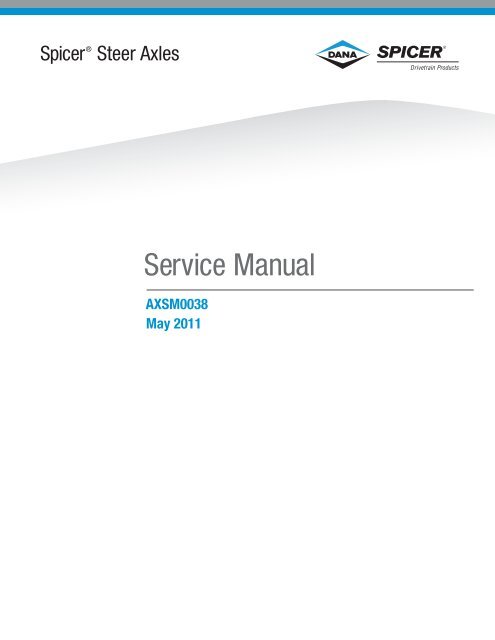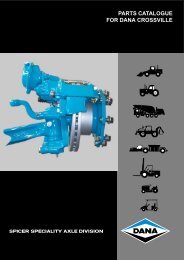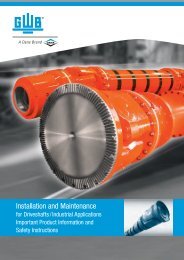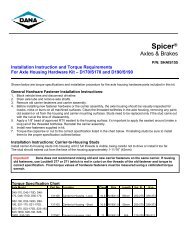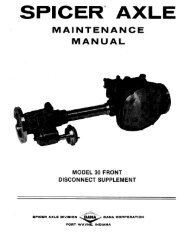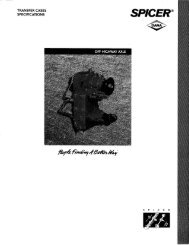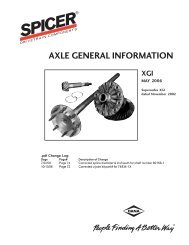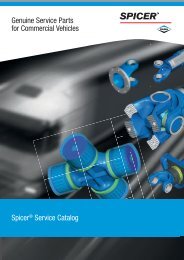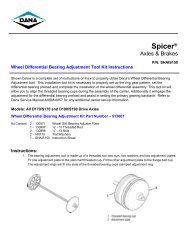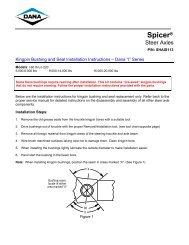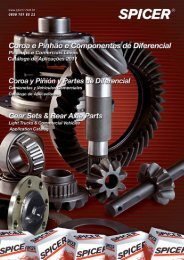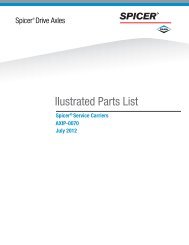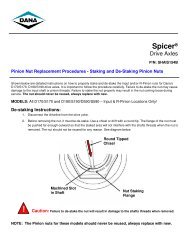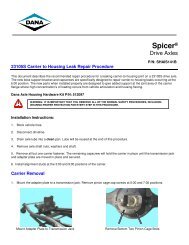2011 Spicer Steer Axles Service Manual
2011 Spicer Steer Axles Service Manual
2011 Spicer Steer Axles Service Manual
You also want an ePaper? Increase the reach of your titles
YUMPU automatically turns print PDFs into web optimized ePapers that Google loves.
<strong>Spicer</strong> ® <strong>Steer</strong> <strong>Axles</strong><br />
<strong>Service</strong> <strong>Manual</strong><br />
AXSM0038<br />
May <strong>2011</strong>
Warnings and Cautions<br />
The description and specifications contained in this service<br />
publication are current at the time of printing.<br />
Dana reserves the right to discontinue or modify its models<br />
and/or procedures and to change specifications at any time<br />
without notice.<br />
Important Notice<br />
This symbol is used throughout this<br />
manual to call attention to procedures<br />
where carelessness or failure to follow<br />
specific instructions may result in<br />
personal injury and/or component<br />
damage.<br />
Departure from the instructions, choice<br />
of tools, materials and recommended<br />
parts mentioned in this publication<br />
may jeopardize the personal safety<br />
of the service technician or vehicle<br />
operator.<br />
Always use genuine <strong>Spicer</strong> replacement parts.<br />
CAUTION<br />
Welding or machining on any axle component is prohibited<br />
unless noted otherwise in this document or other <strong>Spicer</strong><br />
service literature.<br />
Every effort has been made to ensure the accuracy of all<br />
information in this guide. However, Dana makes no<br />
expressed or implied warranty or representation based on<br />
the enclosed information.<br />
Warnings and Cautions<br />
Any reference to brand name in this publication is made as an<br />
example of the types of tools and materials recommended for<br />
use and should not be considered an endorsement. Equivalents<br />
may be used.<br />
WARNING: Failure to follow indicated<br />
procedures creates a high risk of personal<br />
injury to the servicing technician.<br />
CAUTION: Failure to follow indicated<br />
procedures may cause component<br />
damage or malfunction.<br />
IMPORTANT: Highly recommended<br />
procedures for proper service of this unit.<br />
Note: Additional service information not<br />
covered in the service procedures.<br />
Tip: Helpful removal and installation<br />
procedures to aid in the service of this unit.<br />
i<br />
General Information
ii<br />
Warnings and Cautions
Warnings and Cautions ........................................i<br />
Important Notice .......................................................... i<br />
Axle Identification........................................................ 1<br />
Axle Assembly Tag...................................................... 1<br />
Model Information ...................................................... 2<br />
Model Coverage .......................................................... 3<br />
Inspection ...........................................................4<br />
Procedures and Intervals ............................................ 4<br />
E Family Exploded View .............................................. 4<br />
EFA Family Exploded View .......................................... 5<br />
I and D Family Exploded View ..................................... 6<br />
General Inspection ...................................................... 7<br />
Component Inspection ................................................ 7<br />
Knuckle Vertical Play Inspection ................................. 7<br />
Bushing Inspection (End Play) .................................... 8<br />
Tie Rod Inspection ...................................................... 9<br />
................................ Tie Rod End Replacement 11<br />
Straight Socket Tie Rod Ends.................................... 11<br />
Drop Socket Tie Rod Ends ........................................ 11<br />
Alignment / Adjustment ....................................12<br />
Wheel Alignment....................................................... 12<br />
Camber ..................................................................... 12<br />
Caster Adjustment..................................................... 16<br />
Toe Setting................................................................ 17<br />
<strong>Steer</strong>ing Stop Adjustment ......................................... 18<br />
Disassembly, Overhaul, and Assembly .............19<br />
Table of Contents<br />
<strong>Steer</strong>ing Knuckle Disassembly................................... 19<br />
Kingpin Bushing and Seal Replacement .................... 20<br />
<strong>Steer</strong>ing Knuckle Assembly ....................................... 23<br />
Replacing Staked Draw Keys with Threaded.............. 26<br />
Installing Dual Draw Keys.......................................... 27<br />
General Specifications ......................................28<br />
Wheel Bearing Adjustment ........................................ 28<br />
Wheel Alignment ....................................................... 28<br />
Kingpin Clearance – New ........................................... 28<br />
Kingpin Clearance – In <strong>Service</strong> .................................. 28<br />
E Family Fastener Torque Specifications.................... 29<br />
EFA Family Fastener Torque Specifications................ 29<br />
I and D Family Fastener Torque Specifications .......... 30<br />
Wheel Bearing Adjustment ................................31<br />
Stamped Locking Nut System ................................... 32<br />
Single Nut (Castle Nut) Locking System.................... 33<br />
Pro-Torq Spindle Nut <strong>Service</strong> .................................... 34<br />
Special <strong>Service</strong> Tools ........................................36<br />
Additional <strong>Service</strong> Information ..........................37<br />
Appendix ...........................................................38<br />
Lubrication ................................................................ 38<br />
Verify Wheel End-play Procedure .............................. 40<br />
Readjust Wheel End-play Procedure.......................... 40<br />
Table of Contents
Table of Contents
Axle Identification<br />
The <strong>Spicer</strong> front non-drive steering axles are identified with<br />
a tag located between the spring pads on the front side of<br />
the center beam section.<br />
The axle tag contains the serial number, the model number,<br />
and the assembly number.<br />
Axle Assembly Tag<br />
1 - Tag<br />
E Family<br />
1 - Dana Part Number<br />
EFA Family<br />
CUST PART NO. XXXX<br />
SPEC.<br />
XXXXXX<br />
MODEL<br />
XXXXX<br />
MADE IN:<br />
PART NO.<br />
1<br />
SPICER<br />
XXXX<br />
SERIAL NO.<br />
XXXXXXXX<br />
RATIO<br />
XXXXX<br />
<strong>Spicer</strong> Axle<br />
MODEL PART NO.<br />
000000 000000<br />
SPEC. SERIAL NO.<br />
000000000 0000000000<br />
CUST. PT. NO.<br />
0000000000<br />
MADE IN<br />
0000000<br />
1<br />
General Information<br />
I Family<br />
1<br />
2 3 4 5<br />
1 - Dana Part Number<br />
2 - Serial Number<br />
3 - Model Number<br />
4 - Customer Part Number<br />
5 - Line Set Number<br />
6 - Julian Date<br />
Julian Date Code<br />
DO NOT REMOVE<br />
1208N000 0<br />
SER # I-120 S<br />
000000 0000000000<br />
98170<br />
98020<br />
F1 9999<br />
Model Year Day of Year<br />
SPICER<br />
6<br />
1<br />
General Information
Model Information<br />
E Family<br />
Series E, D<br />
GAWR x 100 lbs.<br />
Example:<br />
120 x 100 = 12,000 lbs.<br />
EFA Family<br />
I Family<br />
2<br />
Series<br />
Nominal<br />
Load Capacity<br />
12 = 12,000 lbs.<br />
18 = 18,000 lbs.<br />
22 = 22,000 lbs.<br />
24 = 24,000 lbs.<br />
E -120 0 I<br />
EFA - 12 F 4<br />
I -120 SG<br />
Beam Type<br />
I,F,T–<br />
I-Beam Standard Overall Width<br />
W – Over 96" Overall Width<br />
Design Level<br />
0 - Standard<br />
1 - Heavy-Duty Beam<br />
2 - Maximum Contact Kingpin Joint<br />
3 - Maximum Contact Kingpin Joint<br />
and Heavy-Duty Beam<br />
Beam Drop<br />
1 - 1.5 in. to Tube Centerline<br />
4 - 3.5 in. to Spring Pad<br />
5 - 5.1 in. to Tube Centerline<br />
Beam Type<br />
F = I-Beam Standard Overall Width<br />
T = Tubular Beam<br />
Beam Type/Series SG = I-Beam Standard Overall Width<br />
Nominal Load<br />
Carrying Capacity<br />
60 = 6,000 lbs.<br />
80 = 8,000 lbs.<br />
100 = 10,000 lbs.<br />
120 = 12,000 lbs.<br />
140 = 14,000 lbs.<br />
160 = 16,000 lbs.<br />
180 = 18,000 lbs.<br />
200 = 20,000 lbs.<br />
SB = Coach Beam<br />
W = Over 96" Overall Width<br />
General Information
Model Coverage<br />
E Family<br />
Model Nominal Load Ratings lbs. [kg]<br />
E-1000I<br />
E-1000W<br />
E-1002I<br />
E-1002W<br />
E-1200I<br />
E-1200W<br />
E-1201W<br />
E-1202I<br />
E-1202W<br />
E-1203I<br />
E-1320I<br />
E-1320W<br />
E-1322I<br />
E-1322W<br />
E-1460I<br />
E-1460W<br />
E-1462I<br />
E-1462W<br />
EFA Family<br />
10,000 [4,536]<br />
12,000 [5,443]<br />
13,200 [5,987]<br />
14,600 [6,622]<br />
Model Nominal Load Rating lbs. [kg]<br />
EFA-12F3 Superseded by EFA-12F4<br />
EFA-13F3 Superseded by EFA-12F4<br />
EFA-12F4<br />
EFA-13F5<br />
12,000-13,200<br />
[5,443-5,987]<br />
EFA-18F3 Superseded by EFA-20F4<br />
EFA-20F4 20,000 [9,072]<br />
EFA-22T2<br />
EFA-22T5<br />
EFA-24T2<br />
EFA-24T5<br />
22,000 [9,979]<br />
24,000 [10,886]<br />
General Information<br />
I and D Family<br />
Model Nominal Load Rating lbs. [kg]<br />
I-60SG<br />
D-600N<br />
D-700N<br />
D-700F<br />
D-800F<br />
D-800W<br />
I-80SG<br />
D-850F<br />
D-850W<br />
I-100 S, SG<br />
I-100W<br />
I-120S, SG, SGL<br />
I-120W<br />
I-130SG<br />
I-130W<br />
6,000 [2,722]<br />
7,000 [3,175]<br />
8,000 [3,629]<br />
8,500 [3,856]<br />
10,000 [4,536]<br />
12,000 [5,443]<br />
13,000 [5,896]<br />
I-132SG 13,200 [5,987]<br />
I-140S, SG<br />
I-140W<br />
I-160S, SG<br />
I-160W<br />
I-160SB<br />
I-180S, SG<br />
I-180W<br />
14,600 [6,622]<br />
16,000 [7,257]<br />
18,000 [8,165]<br />
D-2000F 20,000 [9,072]<br />
I-200S, SG<br />
I-200W<br />
20,000 [9,072]<br />
D-2200F 22,800 [10,342]<br />
I-220W 22,800 [10,342]<br />
Note: These nominal ratings are general guidelines. Actual<br />
load rating varies with application and duty cycle. Applications<br />
require <strong>Spicer</strong> engineering approval.<br />
3<br />
General Information
Inspection<br />
Procedures and Intervals<br />
The following inspection procedures are consistent with<br />
industry practice and are recommended as Inspection guidelines<br />
for periodic service. Use manufacturer’s instructions as<br />
a primary guide.<br />
E Family Exploded View<br />
4<br />
24<br />
23<br />
25<br />
22<br />
26<br />
16<br />
17<br />
21<br />
20<br />
19<br />
18<br />
19<br />
18<br />
20<br />
17<br />
16<br />
Inspection<br />
Intervals of inspection or service are recommended for general<br />
or average vehicle use. It may be appropriate to increase<br />
frequency of intervals depending on the type of vehicle service.<br />
1 - Nut, Draw Key 10 - Pin, Cotter 19 - Gasket<br />
2 - Seal, Grease 11 - Bolt, Clamp 20 - Bushing<br />
3 - Shim 12 - Tube, Cross 21 - Kingpin<br />
4 - Axle Beam 13 - Clamp 22 - Nut, outer Spindle*<br />
5 - Key, Draw 14 - Nut 23 - Washer, Retainer*<br />
6 - Bearing, Thrust 15 - Tie Rod End 24 - Washer, Spindle*<br />
7 - Screw, Stop 16 - Lube Fitting 25 - Nut, Inner Spindle*<br />
8 - Nut, Jam 17 - Cap, Knuckle 26 - <strong>Steer</strong>ing Knuckle<br />
9 - Nut, Slotted 18 - Foam Insert 27 - Dual Draw Key Beam<br />
* Nut, Pro-Torq (optional alternative for items 22-25)<br />
9<br />
15<br />
10<br />
1<br />
8<br />
14<br />
11<br />
7<br />
12<br />
13<br />
2<br />
2<br />
3<br />
6<br />
27<br />
5<br />
4
EFA Family Exploded View<br />
8<br />
7<br />
9<br />
10<br />
11<br />
12<br />
Inspection<br />
1 - Lubrication Fitting 11 - Cotter Pin 21 - Woodruff Key<br />
2 - Hex Bolt 12 - Hex Nut, <strong>Steer</strong> Arm 22 - Cross Tube Assembly<br />
3 - Washer 13 - Seal Knuckle 23 - Tie Rod Arm<br />
4 - Knuckle Cap 14 - Shim 24 - <strong>Steer</strong> Arm Ball Stud<br />
5 - Bushing 15 - Thrust Bearing 25 - Ball Stud Nut<br />
6 - Knuckle Pin 16 - Draw Key 26 - Ball Stud Cotter Pin<br />
7 - Washer, Spindle 17 - Nut, Draw Key 27 - <strong>Steer</strong> Arm<br />
8 - Hex Nut, Spindle 18 - Stop Screw 28 - I-Beam<br />
9 - Cotter Pin 19 - Nut, Jam 29 - Tubular Beam<br />
10 - <strong>Steer</strong>ing Knuckle 20 - Cotter Pin<br />
3<br />
2<br />
4<br />
1<br />
5<br />
6<br />
21<br />
17<br />
24<br />
18<br />
21<br />
19<br />
23<br />
15<br />
27<br />
13<br />
14<br />
13<br />
25<br />
26<br />
16<br />
20<br />
29<br />
22<br />
28<br />
5<br />
Inspection
I and D Family Exploded View<br />
6<br />
30<br />
34<br />
35<br />
31<br />
33 32<br />
15<br />
16<br />
Inspection<br />
1 - I-Beam 13 - Bushing, Kingpin 25 - Nut, Tie Rod Clamp<br />
2 - Seal, Kingpin 14 - Kingpin 26 - Clamp, Tie Rod<br />
3 - Shim 15 - Pin, Cotter 27 - Tie Rod End<br />
4 - Draw Key, Outer 16 - Nut, Slotted 28 - Grease Fitting<br />
5 - Draw Key, Inner 17 - Knuckle, <strong>Steer</strong>ing 29 - Arm, Tie Rod<br />
6 - Nut, Draw Key 18 - Bolt, Stop 30 - Pin, Spindle Cotter<br />
7 - Washer, Belleville 19 - Key, Woodruff 31 - Spindle Nut, Inner<br />
8 - Bearing Assembly, Thrust 20 - Arm, <strong>Steer</strong>ing 32 - Nut, Spindle Lock Washer<br />
9 - Bolt, Kingpin Cap 21 - Nut, Tie Rod 33 - Spindle Nut, Outer<br />
10 - Grease Fitting 22 - Pin, Cotter Tie Rod 34 - Washer, Bearing Retainer<br />
11 - Cap, Kingpin 23 - Tube, Cross 35 - Nut, Slotted Spindle<br />
12 - O-Ring 24 - Bolt, Tie Rod Clamp<br />
9<br />
11<br />
13<br />
10<br />
4<br />
10<br />
12<br />
14<br />
17<br />
18<br />
19<br />
19<br />
7<br />
6<br />
8<br />
2<br />
3<br />
20<br />
29<br />
5<br />
28<br />
1<br />
21<br />
27<br />
22<br />
24<br />
26<br />
25<br />
23
General Inspection<br />
Inspect the axle to ensure proper assembly and to identify<br />
broken parts and loose fasteners each time the vehicle is<br />
lubricated. Make sure spring to axle beam mounting nuts and<br />
steering connection fasteners are secure.<br />
Wheel Alignment - Follow vehicle manufacturer’s instructions<br />
for wheel alignment inspection intervals. If excessive steering<br />
effort, vehicle wander, or uneven and/or excessive tire wear is<br />
evident, check wheel alignment. Refer to Wheel Alignment.<br />
<strong>Steer</strong>ing Axle Stops - Inspect for missing, loose or bent steer<br />
stops. Damaged or missing steering axle stops may indicate<br />
other problems with the steering system. This can result in<br />
damage to steering system components. Replace missing or<br />
damaged stops and reset steering system geometry. Refer to<br />
vehicle manufacturer’s instructions for proper steering system<br />
settings.<br />
Tie Rod Ends - Inspect each time axle is lubricated. Check for<br />
seal damage, worn ball socket or loose fasteners.<br />
Knuckle Thrust Bearings - When disassembled, visually<br />
inspect for any damage and check for smooth operation. For<br />
maximum service life, replace the thrust bearing whenever the<br />
knuckle assembly is serviced.<br />
Kingpins - For maximum service life replace kingpins when<br />
servicing knuckle assembly.<br />
Component Inspection<br />
Prepare for axle inspection as follows:<br />
1. Set parking brake and block drive wheels to prevent<br />
vehicle movement.<br />
2. Raise the vehicle until steering axle wheels are off<br />
the ground. Support raised vehicle with safety<br />
stands.<br />
WARNING<br />
Never work under a vehicle supported only by a jack.<br />
Always use safety stands.<br />
Knuckle Vertical Play Inspection<br />
1. Mount dial indicator on axle beam. Reference the dial<br />
indicator probe on the knuckle cap.<br />
2. Using a lever, pry steering knuckle downward.<br />
Inspection<br />
3. Zero the dial indicator.<br />
4. Using a lever, pry the steering knuckle upward. Note<br />
indicator reading. If reading exceeds 0.040" (1.02<br />
mm), refer to Removal and Disassembly for overhaul<br />
procedures.<br />
Note: Perform above inspection procedure with axle assembled<br />
and installed on vehicle with tires and wheels<br />
attached. To check knuckle vertical play during axle<br />
assembly. Refer to <strong>Steer</strong>ing Knuckle Assembly.<br />
E Family<br />
1 - Reference on top of knuckle<br />
2 - Dial indicator<br />
3 - Pry bar<br />
4 - Pry knuckle downward<br />
EFA, I Family<br />
1 - Reference on top of knuckle<br />
2 - Dial indicator<br />
3 - Pry bar<br />
4 - Pry knuckle downward<br />
2<br />
2<br />
1<br />
1<br />
4<br />
4<br />
3<br />
3<br />
7<br />
Inspection
Bushing Inspection (End Play)<br />
Following regular and thorough greasing practices will maximize<br />
bushing life.<br />
Upper Bushing Lateral Inspection<br />
This procedure measures upper bushing wear due to side and<br />
vertical loading.<br />
E Family<br />
8<br />
1. Mount dial indicator on the axle. Reference the upper<br />
part of the steering knuckle.<br />
1 - Dial indicator<br />
2 - Reference on top lip of steering knuckle<br />
3 - Attach to axle beam<br />
EFA, I and D Family<br />
1<br />
1<br />
0<br />
10 10<br />
20<br />
20<br />
30<br />
30<br />
40 40<br />
1 - Dial indicator<br />
2 - Reference on top lip of steering knuckle<br />
3 - Attach to axle beam<br />
2<br />
3<br />
3<br />
2. Move the tire and wheel assembly in and out with a<br />
push/pull motion and have an assistant record the<br />
dial indicator reading.<br />
3. Replace the upper bushing if readings are in excess<br />
of .015" (0.38 mm).<br />
50<br />
2<br />
Inspection<br />
Lower Bushing Lateral Inspection<br />
This procedure measures lower bushing wear due to side and<br />
vertical loading.<br />
E Family<br />
1. Mount dial indicator on the axle. Reference the base<br />
of the lower arm on the steering knuckle.<br />
1 - Attach to axle beam<br />
2 - Reference on lower steering knuckle<br />
3 - Dial indicator<br />
EFA, I and D Family<br />
1<br />
0<br />
10 10<br />
20<br />
20<br />
30<br />
30<br />
40 40<br />
50<br />
1 - Attach to axle beam<br />
2 - Reference on lower steering knuckle<br />
3 - Dial indicator<br />
3<br />
3<br />
1<br />
2. Move bottom of tire and wheel assembly in and out<br />
with a push/pull motion and have an assistant record<br />
dial indicator reading.<br />
3. Replace the lower bushing if dial indicator readings<br />
are in excess of .015" (0.38 mm).<br />
Note: To avoid inaccurate measurements, be careful not to let<br />
the knuckle turn while moving assembly in and out.<br />
Applying brakes will help lock wheel assembly.<br />
Note: Locate indicator on a smooth, flat surface for best reading.<br />
2<br />
2
Tie Rod Inspection<br />
1. Make sure the boot completely covers the ball joint<br />
of the tie rod end with no cracks or tears. If there is<br />
damage to the boot, the entire tie rod end must be<br />
replaced.<br />
1 - Cracked or torn boot requires entire tie rod end replacement<br />
2. Make sure the tie rod nut is torqued to the proper<br />
specifications and the cotter pin is correctly installed<br />
in the nut. If the cotter pin is missing, the tie rod nut<br />
could become loose and steering will be affected.<br />
1 - <strong>Steer</strong>ing knuckle<br />
2 - Missing cotter pin<br />
1<br />
1<br />
2<br />
Inspection<br />
3. The threaded portion of each tie rod end must be<br />
inserted completely in the cross tube split. This is<br />
essential for adequate clamping. Replace components<br />
if this fit cannot be obtained.<br />
CORRECT<br />
The threaded portions of both<br />
tie rod ends must be completely<br />
inserted in cross tube split<br />
4. Where zerk fittings are necessary, make sure they<br />
are installed correctly. (Non-greaseable tie rod ends<br />
do not require zerk fittings.)<br />
5. To protect the cross tube, use only your hands or a<br />
pipe wrench with jaw protectors to rotate the cross<br />
tube. Make sure the cross tube will turn toward the<br />
front and the back of the vehicle. Replace both of the<br />
tie rod ends if they will not turn in both directions.<br />
6. If the cross tubes or clamps are bent, cracked or<br />
damaged, replacement is necessary. Do not attempt<br />
to repair a cross tube as this could result in damage<br />
to the axle.<br />
7. Proper positioning of clamp relative to beam and<br />
correct orientation of nut and bolt are required to<br />
ensure clearance at high wheel cuts.<br />
Boot does not have purging capibilities.<br />
All grease purging takes place through<br />
pureable grease fitting.<br />
Equal threads exposed on<br />
left and right tie rod ends<br />
INCORRECT<br />
Threaded end is not completely<br />
inserted in cross tube split<br />
Purgeable<br />
grease fitting<br />
Note: Tie rods end inspections should always be performed<br />
prior to lubrication. If the inspection is performed after<br />
lubrication, there may be a false indication that the tie<br />
rod end is fully operative.<br />
9<br />
Inspection
10<br />
8. Park the vehicle with the wheels in the “straight<br />
ahead” position, then turn the vehicle off.<br />
9. Place blocks in front of and behind the front and rear<br />
tires to prevent the vehicle from moving.<br />
10. If the seal and ring are acceptable, try to move the tie<br />
rod cross tube by hand.<br />
11. If movement or looseness is detected, set up a dial<br />
indicator as shown below.<br />
CAUTION<br />
Do not use a pry bar or other mechanical method on the<br />
steering linkage. This could result in damage to the tie rod<br />
end and/or create a false indication of wear.<br />
Inspection<br />
12. There are two separate methods that can be used to<br />
check the degree of movement in the tie rod end:<br />
a. To check axial (up and down) movement, set the<br />
dial indicator so the base of the indicator is on the tie<br />
rod arm. Then, place the tip of the indicator on the<br />
bottom of the tie rod end at the area that is most flat.<br />
b. To check radial (back and forth) movement, set<br />
the dial indicator so that the base of the indicator is<br />
on the tie rod arm. Then, place the tip of the indicator<br />
on the socket of the tie rod end. Be sure to position<br />
the dial indicator so that it is in line with the direction<br />
of movement.<br />
13. Set the dial indicator to zero.<br />
14. Again, move the cross tube assembly up and down<br />
or back and forth, depending on which direction you<br />
are checking for looseness. If the indicator reading is<br />
0.060” or more, replace the tie rod end immediately.<br />
If the indicator reading is above 0.030”, it should be<br />
replaced at the next service interval.<br />
CAUTION<br />
Do not remove the tie rod end from the tie rod arm to check<br />
for ball stud rotating torque. This may damage the seal if a<br />
removal tool is used. Additionally, the tie rod end seal can<br />
cause false indications of internal torque.<br />
15. Repeat Steps 10 through 14 for the other tie rod<br />
ends.<br />
Note: When one tie rod end requires replacement, it is recommended<br />
to replace both to allow for even wear on both<br />
sides of the vehicle.
Tie Rod End Replacement<br />
1. Disconnect the tie rod end.<br />
2. If the cross tube is being replaced, count the number<br />
of exposed threads on the tie rod end.<br />
3. Loosen the clamp nut and unscrew the tie rod end.<br />
4. Install new tie rod ends or new cross tube.<br />
Note: Cross tube has right-hand and left-hand threads for<br />
corresponding sides of the vehicle.<br />
5. Thread tie rod end into cross tube past the tube split.<br />
The number of threads exposed from the tube<br />
should be equal on both left and right tie rod ends.<br />
CORRECT<br />
The threaded portions of both<br />
tie rod ends must be completely<br />
inserted in cross tube split<br />
Equal threads exposed on<br />
left and right tie rod ends<br />
INCORRECT<br />
Threaded end is not completely<br />
inserted in cross tube split<br />
6. For E and I straight socket tie rod ends, tighten the<br />
clamp nut to 45-60 ft. lbs. (61-81N m). Make sure<br />
the tab on the clamp holds the end of the cross tube.<br />
Straight Socket Tie Rod Ends<br />
D, E, & I Series 45-60 ft.lbs. (61-81 N•m)<br />
7. For drop socket tie rod ends, tighten as follows:<br />
Tie Rod End Replacement<br />
Drop Socket Tie Rod Ends<br />
I-120SG, I-140SG, I-132SG,<br />
E-1462I<br />
E-1460I, E-1320W, E-1322W<br />
E-1460W, E-1462W<br />
I-200SG, I-200W, I-220W,<br />
I-160W, I-180W<br />
8. Install tie rod end into knuckle tie rod arm. Secure<br />
with slotted nut and tighten to 120-160 ft. lbs. (163-<br />
217 N m).<br />
9. Install the cotter pin in the slotted nut and bend the<br />
ends to secure. If necessary, tighten the nut until the<br />
holes align.<br />
10. Adjust toe-in.<br />
55-70 ft. lbs.<br />
(75-95 N m)<br />
80-90 ft. lbs.<br />
(108-122 N m)<br />
150-180 ft. lbs.<br />
(203-244 N m)<br />
D-2000F, D2200F 150-180 ft. lbs.<br />
(203-244 N m)<br />
1<br />
1 - Tie rod arm<br />
2 - Tie rod end<br />
3 - Slotted nut<br />
4 - Cotter pin<br />
5 - Position clamp fastener away from beam<br />
Note: On tie rods with rotating clamp, position clamp with<br />
fastener away from beam.<br />
2<br />
4<br />
3<br />
5<br />
11<br />
Tie Rod End Replacement
Alignment / Adjustment<br />
Wheel Alignment<br />
Correct wheel alignment promotes longer tire wear and ease<br />
of handling while minimizing strain on the steering system<br />
and axle components. Use vehicle manufacturer’s instructions<br />
to inspect wheel alignment.<br />
Note: Total vehicle alignment is recommended when aligning<br />
the steer axle.<br />
Camber<br />
Camber is the vertical tilt of the wheel as viewed from the<br />
front of the vehicle. This is machined in at time of manufacture<br />
and is not adjustable.<br />
“Positive” camber is an outward tilt of the wheel at the top.<br />
1 - Positive camber<br />
2 - Vertical center line<br />
Camber for E-1000I, E-1000W, E-1200I, E-1200W,<br />
E-1201W, E-1320I, E-1320W, E-1460I, E-1460W<br />
Left<br />
Right<br />
12<br />
1<br />
2<br />
Alignment / Adjustment<br />
“Negative” camber is an inward tilt of the wheel at the top.<br />
1<br />
1 - Vertical center line<br />
2 - Negative camber<br />
On Bench Unloaded<br />
(8000 lbs.)<br />
1/<br />
2°<br />
( + / -7/<br />
16°<br />
)<br />
1/<br />
4°<br />
( + / -7/<br />
16°<br />
)<br />
<strong>Spicer</strong> expressly prohibits bending of axle beams (hot or<br />
cold) to change camber or for any other purpose. Welding<br />
or machining on any axle component is prohibited<br />
unless noted otherwise in this document or other <strong>Spicer</strong><br />
service literature.<br />
3/<br />
16°<br />
( + / -7/<br />
16°<br />
)<br />
-1/<br />
16°<br />
( + / -7/<br />
16°<br />
)<br />
2<br />
CAUTION<br />
Loaded<br />
0°<br />
( + / -7/<br />
16°<br />
)<br />
-1/<br />
4°<br />
( + / -7/<br />
16°<br />
)
Camber for E-1002I, E-1002W, E-1202I, E-1202W, E-1203I<br />
E-1322I, E-1322W, E-1462I, E-1462W<br />
Camber for EFA-12F3, EFA-12F4, EFA-13F3, EFA-13F5<br />
Camber for EFA-18F3, EFA-20F4<br />
Camber for EFA-22T, EFA-24T<br />
Camber for I-60SG, I-80SG<br />
Alignment / Adjustment<br />
On Bench Unloaded<br />
(8000 lbs.)<br />
Loaded<br />
Left 5/8° (+/-7/16°) 1/4° (+/-7/16°) +1/8° (+/-7/16°)<br />
Right 3/8° (+/-7/16°) 0° (+/-7/16°) -1/8° (+/-7/16°)<br />
On Bench Unloaded<br />
(8000 lbs.)<br />
Loaded<br />
Left 3/4° (+/-7/16°) 7/16° (+/-7/16°) 1/4° (+/-7/16°)<br />
Right 1/4° (+/-7/16°) -1/16° (+/-7/16°) -1/4° (+/-7/16°)<br />
On Bench Unloaded<br />
(10,000 lbs.)<br />
Loaded<br />
Left 3/4° (+/-7/16°) 1/2° (+/-7/16°) 1/4° (+/-7/16°)<br />
Right 1/4° (+/-7/16°) 0° (+/-7/16°) -1/4° (+/-7/16°)<br />
On Bench Unloaded<br />
(12,000 lbs.)<br />
Loaded<br />
Left 1/2° (+/-7/16°) 1/4° (+/-7/16°) 0° (+/-7/16°)<br />
Right 1/2° (+/-7/16°) 1/4° (+/-7/16°) 0° (+/-7/16°)<br />
On Bench Unloaded<br />
(8,000 lbs.)<br />
Loaded<br />
Left 3/4° (+/-7/16°) 3/8° (+/-7/16°) 1/4° (+/-7/16°)<br />
Right 1/2° (+/-7/16°) 1/8° (+/-7/16°) 0° (+/-7/16°)<br />
13<br />
Alignment / Adjustment
Camber for D-600N, D-700F, D-700N, D-800F, D-<br />
800W<br />
Camber for I-100SG, I-120SG, I-130SG, I-132SG,<br />
I-140SG, I-146SG, I-160SG, I-180SG, I-200SG prior to<br />
Oct. 2001<br />
Camber for I-100SG, I-120SG, I-140SG, I-146SG,<br />
I-160SG, I-180SG, I-200SG after Oct. 2001<br />
Camber for I-100NGV, I-120NGV, I-140NGV prior to<br />
Oct. 2001<br />
Camber for I-100NGV, I-120NGV, I-140NGV after Oct.<br />
2001<br />
14<br />
Alignment / Adjustment<br />
On Bench Unloaded<br />
(8,000 lbs.)<br />
Loaded<br />
Left 5/8° (+/-7/16°) 1/4° (+/-7/16°) +1/8° (+/-7/16°)<br />
Right 3/8° (+/-7/16°) 0° (+/-7/16°) -1/8° (+/-7/16°)<br />
On Bench Unloaded<br />
(8,000 lbs.)<br />
Loaded<br />
Left 1/4° (+/-7/16°) -1/8° (+/-7/16°) -1/4° (+/-7/16°)<br />
Right 1/4° (+/-7/16°) -1/8° (+/-7/16°) -1/4° (+/-7/16°)<br />
On Bench Unloaded<br />
(8,000 lbs.)<br />
Loaded<br />
Left 5/8° (+/-7/16°) 1/4° (+/-7/16°) +1/8° (+/-7/16°)<br />
Right 3/8° (+/-7/16°) 0° (+/-7/16°) -1/8° (+/-7/16°)<br />
On Bench Unloaded Loaded<br />
Left 1/4° (+/-7/16°) -1/8° (+/-7/16°) -1/4° (+/-7/16°)<br />
Right 1/4° (+/-7/16°) -1/8° (+/-7/16°) -1/4° (+/-7/16°)<br />
On Bench Unloaded Loaded<br />
Left 5/8° (+/-7/16°) 1/4° (+/-7/16°) +1/8° (+/-7/16°)<br />
Right 3/8° (+/-7/16°) 0° (+/-7/16°) -1/8° (+/-7/16°)
Camber for I-100W, I-120W, I-130W, I-140W, I-160W,<br />
I-180W, I-200W, I-220W<br />
Camber for D-2000F (5” Drop)<br />
Chamber for D-2000F<br />
Chamber for D-2200F<br />
Alignment / Adjustment<br />
On Bench Unloaded Loaded<br />
Left 5/8° (+/-7/16°) 1/4° (+/-7/16°) +1/8° (+/-7/16°)<br />
Right 3/8° (+/-7/16°) 0° (+/-7/16°) -1/8° (+/-7/16°)<br />
On Bench Unloaded (10,000 lbs) Loaded<br />
Left 1/4° (+/-7/16°) 0° (+/-7/16°) -3/16° (+/-7/16°)<br />
Right 1/4° (+/-7/16°) 0° (+/-7/16°) -3/16° (+/-7/16°)<br />
On Bench Unloaded (10,000 lbs) Loaded<br />
Left 5/8° (+/-7/16°) 13/32° (+/-7/16°) 1/8° (+/-7/16°)<br />
Right 3/8° (+/-7/16°) 5/32° (+/-7/16°) 0° (+/-7/16°)<br />
On Bench Unloaded (10,000 lbs) Loaded<br />
Left 5/8° (+/-7/16°) 13/32° (+/-7/16°) 1/8° (+/-7/16°)<br />
Right 3/8° (+/-7/16°) 5/32° (+/-7/16°) -1/16° (+/-7/16°)<br />
15<br />
Alignment / Adjustment
Caster Adjustment<br />
Caster is the fore and aft tilt (toward front or rear of vehicle) of<br />
the steering kingpin as viewed from the side of the vehicle.<br />
“Positive” caster is the tilt of the top of the kingpin toward the<br />
rear of the vehicle.<br />
1 - Vertical center line<br />
2 - Kingpin center line<br />
3 - Front of truck<br />
4 - Rear of truck<br />
“Negative” caster is the tilt of the top of the kingpin toward the<br />
front of the vehicle.<br />
16<br />
3<br />
3<br />
1<br />
1<br />
1 - Kingpin center line<br />
2 - Vertical center line<br />
3 - Front of truck<br />
4 - Rear of truck<br />
2<br />
2<br />
4<br />
4<br />
Alignment / Adjustment<br />
Also Reference RP 642, Guidelines for Total Vehicle Alignment<br />
published by the Truck Maintenance Council.<br />
A caster angle more positive than specified may result in<br />
excessive steering effort and/or shimmy. An angle less positive<br />
may result in vehicle wander or poor steering return to<br />
center. Caster angle is determined by the installed position of<br />
the steer axle.<br />
Caster is adjusted by adding or removing taper wedges<br />
between the springs and axle beam mounting pad.<br />
The caster angle is generally more positive with power steering,<br />
since the power-assist overcomes excessive steering<br />
effort. This enables the vehicle to exhibit maximum straight<br />
ahead steering stability (common range for power steering<br />
units is +2° to +4°).<br />
OEM<br />
Refer to OEM vehicle specifications.<br />
Note: Adjust caster to vehicle manufacturer specifications.<br />
CAUTION<br />
<strong>Spicer</strong> expressly prohibits twisting of axle beam for<br />
caster adjustment or any straightening purposes.<br />
Note: Changing the torquing sequence on U-bolts may result<br />
in slight changes in caster.
Toe Setting<br />
1. Use a work bay with a level floor.<br />
2. Drive the vehicle into bay slowly and straight ahead.<br />
Try to roll to a stop without the use of brakes.<br />
3. Chock the rear wheels.<br />
4. Place a 5" (127 mm) long piece of masking tape parallel<br />
to the center tread rib on the rear of both tires,<br />
half way up the tire height.<br />
5. Position a trammel bar behind the front tires. The<br />
pointers should be raised/lowered until they are at<br />
the hub’s centerline height.<br />
6. With the trammel bar pointers at the hub’s centerline<br />
height, place the pointers at the outside edges of the<br />
masking tape and secure the pointer set screws.<br />
7. Mark the location of one of the pointers with a simple<br />
horizontal mark on the masking tape.<br />
8. Remove the trammel bars from behind the wheels.<br />
9. Roll the truck forward until the mark on the tape<br />
travels 180-degrees.<br />
Alignment / Adjustment<br />
10. Position the trammel bar at the front of the tires.<br />
Position the pointer to the edge of the tape on the<br />
side that has the horizontal mark. The pointer and<br />
the mark should be at the same height.<br />
11. Measure the toe between the pointer and the edge of<br />
the tape on the opposite tire to get the total toe measurement.<br />
Note: Toe-in specification is 1/16” (1.587 mm) for unloaded<br />
vehicles. This applies to a tractor (less trailer) or straight<br />
truck with no load.<br />
12. If the toe measurement is incorrect, loosen the tube<br />
clamp and bolt on the end of each of the cross tubes.<br />
Turn the cross tubes until the specified distance is<br />
reached.<br />
13. Make sure the threaded portion of the tie ends are<br />
inserted completely and are visible in the complete<br />
cross tube slot. Tighten the bolt and nut on the ends<br />
of the cross tube to the specified torque.<br />
14. Check the toe settings again.<br />
Also Reference RP 642, Guidelines for Total Vehicle Alignment<br />
published by the Truck Maintenance Council.<br />
Front of vehicle<br />
A<br />
Toe-In<br />
Distance at front of tire is less<br />
than distance at rear of tire<br />
A<br />
Toe-Out<br />
Distance at front of tire is greater<br />
than distance at rear of tire<br />
B<br />
B<br />
17<br />
Alignment / Adjustment
<strong>Steer</strong>ing Stop Adjustment<br />
18<br />
1. Check vehicle manufacturer’s manual to determine<br />
correct steering stop angle.<br />
2. Check steering angle with alignment turntable set.<br />
3. If adjustment is required, loosen jam nut and turn<br />
stop screw as necessary. See options A and B.<br />
Option A:<br />
5<br />
1<br />
2<br />
1 - Front of vehicle<br />
2 - <strong>Steer</strong>ing knuckle<br />
3 - Axle beam<br />
4 - <strong>Steer</strong>ing stop adjustment (both ends of axle)<br />
5 - Degree of steering angle<br />
1 - Jam nut (90-120 lbs. ft. [122-163N•m])<br />
2 - Stop screw<br />
4<br />
Note: Options for E-1203I and E-1462I are as follows.<br />
1<br />
3<br />
2<br />
Alignment / Adjustment<br />
Option B:<br />
1 - Extension<br />
2 - Jam nut (30-45 lbs. ft. [41-61 N m]<br />
3 - Stop screw<br />
4. After adjustment, tighten stop screw jam nut to:<br />
Option A: 90-120 lbs. ft. (122-163 N m).<br />
Option B: 30-45 lbs. ft. (41-61 N m)<br />
Note: Refer to OEM vehicle specifications.<br />
OEM<br />
Note: Adjust power steering unit so that power<br />
assist stops approximately 3° or 1/8” (3.175<br />
mm) before touching the stop screws. Follow<br />
vehicle manufacture recommendations when<br />
making this adjustment.<br />
<strong>Steer</strong>ing gear must be functioning properly or steering linkage<br />
damage may occur. Poppet relief must be checked after<br />
adjusting stop screw setting.<br />
1<br />
CAUTION<br />
2 3
Disassembly, Overhaul, and Assembly<br />
<strong>Steer</strong>ing Knuckle Disassembly<br />
Preparation<br />
1. Set parking brake and block drive wheels to prevent<br />
vehicle movement.<br />
2. Raise vehicle until steer axle tires are off the ground.<br />
Support raised vehicle with safety stands.<br />
Never work under a vehicle supported by only a jack.<br />
Always use safety stands.<br />
Procedure<br />
1. Loosen the slack adjuster to return brake shoes to<br />
the released position and clear drum.<br />
2. Remove hub cap, cotter pin, nut, washer, and outer<br />
bearing cone assembly.<br />
3. Remove wheel and hub assembly.<br />
4. Disconnect air or hydraulic line from the brake<br />
assembly.<br />
Note: Plug or cap line to prevent brake system contamination.<br />
5. Remove brake assembly.<br />
6. Remove cotter pin and slotted nut.<br />
1<br />
WARNING<br />
2<br />
4<br />
1 - Tie rod arm<br />
2 - Tie rod end<br />
3 - Slotted nut<br />
4 - Cotter pin<br />
5 - Position clamp fastener away from beam<br />
Disassembly, Overhaul, and<br />
Assembly<br />
3<br />
5<br />
7. Disconnect tie rod end from tie rod arm using a suitable<br />
tool such as a pickle fork.<br />
1 - Tie rod arm<br />
2 - Tie rod end<br />
3 - Pickle fork<br />
Note: If boot is torn during removal, tie rod end must be<br />
replaced.<br />
Do not use heat on any axle parts or fasteners.<br />
8. Disconnect drag link from steering arm by removing<br />
cotter pin and slotted nut.<br />
9. Remove top and bottom knuckle caps.<br />
10. Single draw key. Remove nut from draw key, then<br />
drive key out using a brass hammer and drift.<br />
1 - Single draw key<br />
2 - Brass drift<br />
CAUTION<br />
3<br />
1<br />
1<br />
2<br />
2<br />
19<br />
Disassembly, Overhaul,<br />
and Assembly
20<br />
11. Dual draw keys. Remove both draw key nuts. Then<br />
drive key out using a brass hammer and drift.<br />
12. Drive kingpin out with a brass hammer and drift.<br />
1 - Brass hammer<br />
2 - Drift<br />
13. Remove steering knuckle from axle beam.<br />
Never strike hardened metal parts with a steel hammer or<br />
tool.<br />
Cleaning<br />
After disassembly and before attempting inspection, clean<br />
parts as follows:<br />
1. Steel parts with ground or polished surfaces.<br />
Wash in suitable cleaning solvent.<br />
Rinse thoroughly to remove cleaning solution.<br />
Dry parts with clean rags.<br />
2. Clean castings, forgings and other rough-surface<br />
parts.<br />
Wire brush or steam-clean areas that are susceptible<br />
to accumulation of mud, road dirt, salt.<br />
Gasoline is not an acceptable cleaning solvent because of<br />
its extreme combustibility. It is unsafe in the workshop<br />
environment.<br />
Kingpin Bushing and Seal Replacement<br />
Removal<br />
WARNING<br />
WARNING<br />
1. Remove grease seals from knuckle arms using suitable<br />
tool.<br />
2<br />
Disassembly, Overhaul, and<br />
Assembly<br />
1<br />
Remove Kingpin Bushings<br />
2. Drive bushings out of knuckles using suitable piloted<br />
drift.<br />
1 - Pilot<br />
2 - Drift<br />
3 - <strong>Steer</strong>ing knuckle<br />
3. Remove all foreign material from kingpin bore of<br />
steering knuckle and axle beam bore.<br />
4. Wire brush machined surfaces taking care not to<br />
damage them. Clean kingpin bores.<br />
1 - Clean all machined surfaces<br />
1<br />
During removal and installation procedures, never use<br />
steel hammer or tool to strike hardened metal parts.<br />
1<br />
3<br />
WARNING<br />
2
Bushing Installation<br />
5. Lightly lubricate outside diameter of bushings to<br />
ease installation.<br />
6. Hand start bushing in bore.<br />
2<br />
Note: When installing kingpin bushings, position seam in<br />
areas marked “X”.<br />
Bushing Seam<br />
Locate in Either<br />
Area Marked "X"<br />
1<br />
7. Drive bushings in until they are located as shown.<br />
X<br />
90˚<br />
X<br />
Disassembly, Overhaul, and<br />
Assembly<br />
Use same method to install both upper and lower<br />
bushings.<br />
See Bushing Depth Chart<br />
(Top)<br />
See Bushing Depth Chart<br />
(Bottom)<br />
Bushing Depth Chart<br />
D-600N, D-700F, D-700N,<br />
D-800F, D-800W<br />
Bushing Depth<br />
.17" (4.3 mm) Top<br />
.56" (14.2 mm) Bottom<br />
D-2000F, D2200F .55" (14.0 mm)<br />
E-1000I, E-1002I, E-1200I, .55" (14.0 mm)<br />
E-1202I, E-1320I, E-1322I,<br />
E-1201I, E-1203I<br />
E-1000W, E-1200W<br />
E-1320W, E-1460I, E-1002W,<br />
E-1202W, E-1322W,<br />
E-1462I, E-1460W,<br />
E-1462W<br />
.55" (14.0 mm)<br />
EFA Family .25" (6.4 mm)<br />
I-100W, I-120W, I-140W,<br />
I-160W, I-180W, I-200W,<br />
I-220W, I-130W<br />
I-130SG, I-132SG, I-140SG,<br />
I-160SG, I-180SG, I-1200SG<br />
.20" (5.1 mm) Top<br />
.20" (5.1 mm) Bottom<br />
.20" (5.1 mm) Top<br />
.20" (5.1 mm) Bottom<br />
I-60SG, I-80SG .17" (4.3 mm) Top<br />
.34" (8.6 mm) Bottom<br />
I-100SG, I-100SGL, I-120SG,<br />
I-120SGL<br />
Recess<br />
Grease Seals<br />
.060" (1.52 mm) From<br />
Knuckle Surface<br />
Bushing<br />
Bushing<br />
.40” (10.2 mm) Top<br />
1.12” (28.4 mm) Bottom<br />
21<br />
Disassembly, Overhaul,<br />
and Assembly
Note: Some <strong>Spicer</strong> kingpin bushings require reaming<br />
after installation. Read the instruction sheet included<br />
with the service kit or bushings BEFORE beginning<br />
installation. For dimensions of bushings requiring reaming,<br />
refer to the Kingpin Bushing Specifications chart<br />
shown in the Appendix.<br />
22<br />
8. Ream bushings to proper size using appropriate<br />
Kent-Moore tool (or equivalent).<br />
9. Install new seal, using suitable pilot drift or similar<br />
device that will not damage seal as it is installed.<br />
.060"<br />
(1.52 mm)<br />
Install<br />
Top Seal<br />
Lip Down<br />
.060" (1.52 mm)<br />
Install<br />
Bottom<br />
Seal<br />
Lip Up<br />
When installing grease seal, be sure lip is pointing toward<br />
center of knuckle. This is essential for correct seal operation.<br />
Lip<br />
CAUTION<br />
Disassembly, Overhaul, and<br />
Assembly
<strong>Steer</strong>ing Knuckle Assembly<br />
Note: Always replace kingpin, thrust bearing and bushings if<br />
any component is faulty.<br />
1. Before installing the kingpins, lubricate inside of<br />
bushing and outside of kingpins with Fleetrite EP2<br />
Moly Grease or equivalent NLGI No. 2 multipurpose<br />
lithium grease to provide initial lubrication.<br />
2. Make certain that kingpin hole in axle center is clean<br />
and dry.<br />
3. There may be two styles of thrust bearings. One type<br />
is installed on thrust bearing with seal on top, as<br />
show in the following figure. Position and support<br />
the steering knuckle assembly on the axle end.<br />
1 - Seal cap<br />
2 - Thrust bearing<br />
4. The second style thrust bearing is a one piece design<br />
with seal LIP installed TOWARDS the bottom of the<br />
knuckles as show in the following figure.<br />
5. Slide the thrust bearing between the lower face of<br />
axle center and lower steering knuckle yoke.<br />
1 - <strong>Steer</strong>ing knuckle<br />
2 - Thrust bearing<br />
3 - Axle beam<br />
3<br />
2<br />
1<br />
Disassembly, Overhaul, and<br />
Assembly<br />
2<br />
1<br />
6. Align the steering knuckle yoke holes with axle and<br />
thrust bearing holes.<br />
7. Pre-adjust knuckle vertical play by wedging the<br />
steering knuckle up and filling the gap at the top side<br />
of the knuckle with shim(s).<br />
1 - Install shim(s) as needed<br />
2 - Shim only top of knuckle<br />
Note: Floor jack can be used to wedge up steering knuckle.<br />
8. Install kingpin from the top with notch and draw key<br />
hole aligned. Hand start pin in bushing.<br />
1 - Kingpin<br />
2 - <strong>Steer</strong>ing knuckle<br />
2<br />
1<br />
Never shim on the bottom side of the beam.<br />
1<br />
CAUTION<br />
2<br />
23<br />
Disassembly, Overhaul,<br />
and Assembly
24<br />
9. Install kingpin in knuckle and axle beam. Tap kingpin<br />
in place using hammer and brass drift if necessary.<br />
1 - Kingpin<br />
2 - Protect with shim stock<br />
Protect kingpins with a suitable material such as shim<br />
stock.<br />
Note: At this point in reassembly, check knuckle vertical play<br />
and adjust if necessary.<br />
10. Center steering components.<br />
11. Mount dial indicator to steer beam and reference top<br />
of the knuckle. Zero dial indicator.<br />
1 - Reference on top of knuckle<br />
2 - Dial indicator<br />
3 - Pry bar<br />
4 - Pry knuckle downward<br />
2<br />
2<br />
CAUTION<br />
1<br />
4<br />
1<br />
Disassembly, Overhaul, and<br />
Assembly<br />
3<br />
12. Simulate axle loading with a jack and note dial indicator<br />
reading.<br />
1 - <strong>Steer</strong>ing knuckle<br />
2 - Jack<br />
Note: Floor jack can be used to wedge up steering knuckle.<br />
13. Knuckle vertical play should be .002” -.012”<br />
(.051 -.305 mm). Add or remove shims as necessary<br />
to obtain correct end play. Center shims to prevent<br />
damage during assembly.<br />
14. When vertical play adjustment is correct, align draw<br />
key opening and pin flat alignment.<br />
4<br />
Simulate axle<br />
loading with<br />
a jack<br />
3<br />
1 - Kingpin notch<br />
2 - Kingpin<br />
3 - <strong>Steer</strong> knuckle<br />
4 - Single draw key<br />
5 - Dual draw keys<br />
2<br />
Correct<br />
15. Install new draw key. For information about installing<br />
dual draw keys, see Installing Dual Draw Keys.<br />
5<br />
1<br />
2<br />
Incorrect<br />
1
16. Seat draw key with a hammer and punch.<br />
1 - Draw key<br />
2 - Brass hammer<br />
17. Install draw key nut and tighten. Refer to torque<br />
charts in Appendix.<br />
1 - Draw key nut<br />
18. Ensure draw key is fully seated by repeating step 16<br />
and 17. Recheck draw key nut torque.<br />
19. Install kingpin caps. Tighten caps. Refer to torque<br />
charts in Appendix.<br />
Note: Tighten nut to range minimum in steps 17 and 19, then<br />
tighten just enough to align cotter pin hole.<br />
20. Attach drag link to steering arm. Install and torque<br />
nut to vehicle manufacturer recommended torque.<br />
21. Install cotter pin.<br />
1<br />
1<br />
2<br />
Disassembly, Overhaul, and<br />
Assembly<br />
22. Attach tie rod end to tie rod arm on knuckle. Install<br />
nut and tighten. Refer to torque charts in Appendix.<br />
23. Install cotter pin.<br />
24. Grease all kingpin and tie rod assemblies.<br />
25<br />
Disassembly, Overhaul,<br />
and Assembly
Replacing Staked Draw Keys with<br />
Threaded<br />
I-100SA and Up<br />
Threaded draw keys on axle codes I-100SA and up will<br />
replace staked draw keys as follows:<br />
26<br />
1. Install top draw key with the threaded end of key to<br />
front of axle as shown.<br />
1 - Belleville washers<br />
2 - Top draw key<br />
3 - Bottom draw key<br />
2. To seat the draw key, strike the unthreaded end of<br />
key with the drift and a hammer.<br />
3. Install Belleville washers as shown in the previous<br />
illustration.<br />
4. Install nut and tighten as specified in the torque<br />
chart in the Appendix.<br />
5. Install bottom draw key with threaded end to rear of<br />
axle.<br />
6. Repeat steps 2, 3, and 4 to finish installation of bottom<br />
draw key.<br />
1<br />
2<br />
3<br />
Disassembly, Overhaul, and<br />
Assembly<br />
I-60SG and I-80SG<br />
<strong>Axles</strong> coded I-60SG and I-80SG have one threaded and one<br />
staked draw key.<br />
For the staked keys the large end should seat flush to .060<br />
inch (0.0 to 1.52 mm) recessed after being driven into place,<br />
as shown in the following figure. Draw keys must be driven<br />
into axle from opposite sides.<br />
1 - I-beam axle<br />
2 - Threaded draw key<br />
3 - Staked draw key<br />
4 - Kingpin<br />
Note: Draw keys must be installed, one from each side of the<br />
axle. Do not install both pins from the same side of the<br />
axle.<br />
4<br />
3<br />
2<br />
4<br />
1<br />
1<br />
3<br />
Front<br />
Front
E-14621<br />
1. Align the draw key opening and the pin flat alignment.<br />
4<br />
3<br />
1 - Kingpin notch<br />
2 - Kingpin<br />
3 - <strong>Steer</strong> knuckle<br />
4 - Single draw key<br />
5 - Dual draw keys<br />
2. Install new draw key.<br />
Note: Draw keys must be installed from one side of the axle.<br />
Do not install pin on either side on the axle<br />
3. Seat draw key with a hammer and punch.<br />
4. Install draw key spring washers as shown.<br />
5. Install draw key nut and tighten as specified in the<br />
torque chart in the Appendix.<br />
6. Ensure that draw key is fully seated by reseating with<br />
a hammer and punch.<br />
7. Recheck draw key nut torque.<br />
2<br />
5<br />
Correct<br />
Incorrect<br />
Disassembly, Overhaul, and<br />
Assembly<br />
1<br />
Installing Dual Draw Keys<br />
I-Series<br />
1. Before staking the tapered draw keys, position kingpin<br />
vertically so it will not contact either the upper or<br />
lower caps.<br />
2. Stake beam material adjacent to each key in three<br />
places to lock key into place.<br />
3<br />
1 - Staked draw key<br />
2 - Threaded draw key<br />
3 - Front<br />
1<br />
2<br />
3. Install kingpin caps and O-ring. Tighten cap bolts to<br />
specified value in the torque chart in the Appendix.<br />
4. To make sure the kingpins will accept lubricant,<br />
lubricate upper and lower kingpin bushings through<br />
the cap grease fittings. If problems arise, you will not<br />
have to remove the brakes again to make repairs.<br />
5. Reinstall tie rod ends into the steering arms and<br />
tighten the nuts to the specified value in the torque<br />
chart. Then install the cotter pin. Refer to the Tie Rod<br />
section for replacement of tie rod ends.<br />
27<br />
Disassembly, Overhaul,<br />
and Assembly
General Specifications<br />
Wheel Bearing Adjustment<br />
End-play .001”-.005” (.025-.125 mm)<br />
(See Wheel Bearing Adjustment for adjustment procedure).<br />
Wheel Alignment<br />
(See vehicle manufacturer for specifications).<br />
Kingpin Clearance – New<br />
Vertical –.002”-.012” (.051-.305 mm)<br />
(See <strong>Steer</strong>ing Knuckle Assembly.)<br />
28<br />
General Specifications<br />
Kingpin Clearance – In <strong>Service</strong><br />
Vertical – .040” max. (1.016 mm)<br />
(See Component Inspection.)<br />
Lateral –.015” max. (.381 mm)<br />
(See Bushing Inspection.)<br />
Note: Correct tightening torque values are extremely important<br />
to assure long axle life and dependable performance.<br />
Under-tightening of attaching parts is just as<br />
harmful as over-tightening.<br />
Note: Exact compliance with recommended torque values will<br />
assure the best results.<br />
Note: Some applications use 5/8-18-UNF for this fastener.<br />
The same torque values apply.<br />
Bolt head markings for<br />
grade indentification<br />
Grade 5 Grade 8<br />
Kingpin Bushing Specifications<br />
The chart below should be used if installing kingpin bushings that require reaming. Read instruction sheet included with the service<br />
kit or bushing BEFORE installing them.<br />
SPICER<br />
MODEL<br />
Kingpin<br />
Bushing<br />
Diameter I.D.<br />
Kingpin<br />
Diameter<br />
I-Beam Bore<br />
Diameter<br />
E-1000I<br />
E-1200I<br />
E-1203I<br />
E-1320I<br />
in.<br />
(mm)<br />
1.7960-1.7950<br />
(45.618-45.593)<br />
1.7937-1.7935<br />
(45.560-45.555)<br />
1.7959-1.7945<br />
(45.616-45.580)<br />
E-1460I<br />
E-1202I<br />
E-1322I<br />
E-1462I<br />
EFA-18F3<br />
EFA-20F4<br />
in.<br />
(mm)<br />
1.8750-1.8740<br />
(47.625-47.600)<br />
1.8729-1.8725<br />
(47.572-47.562)<br />
1.8749-1.8735<br />
(47.623-47.587)<br />
EFA-12F4<br />
EFA-13F5<br />
in.<br />
(mm)<br />
1.6275-1.6265<br />
(41.339-41.313)<br />
1.6255-1.6250<br />
(41.288-41.275)<br />
1.6270-1.6260<br />
(41.326-41.300)<br />
I-60SG<br />
I-80SG<br />
D-600N<br />
D-700F<br />
D-700N<br />
D-800F<br />
D-800W<br />
in.<br />
(mm)<br />
1.3600-1.3615<br />
(34.544-34.582)<br />
1.3587-1.3592<br />
(34.511-34.524)<br />
1.3597-1.3607<br />
(34.536-34.562)<br />
I-100SA/SG<br />
I-120SA/SG<br />
I-130SG<br />
I-130W<br />
I-140SA/SG<br />
I-146SA/SG<br />
in.<br />
(mm)<br />
1.8608-1.8652<br />
(47.264-47.376)<br />
1.8595-1.8600<br />
(47.231-47.244)<br />
1.8608-1.8622<br />
(47.264-47.300)<br />
I-160SG<br />
I-180SG<br />
I-200SG<br />
D-2000F<br />
D-2200F<br />
in.<br />
(mm)<br />
2.0470-2.0514<br />
(51.994-52.105)<br />
2.0457-2.0462<br />
(51.973-51.986)<br />
2.0470-2.0480<br />
(51.994-52.019)
E Family Fastener Torque Specifications<br />
EFA Family Fastener Torque Specifications<br />
Note: Torque nut to the range minimum, then tighten further<br />
to align cotter pin hole. Check torque to make sure it<br />
does not exceed range maximum. If it does, use a new<br />
nut.<br />
General Specifications<br />
Description Fastener Torques<br />
lbs. ft. (N m)<br />
Socket Size<br />
Nut, Draw Key (Single) 1/2-20-UNF-2B 30-45 (41-61) 3/4” 6 point<br />
Nut, Draw Key (Dual) 3/8-16-UNC-2A 24-36 (33-49) 9/16” 6 point<br />
Stop Screw 5/8-18-UNF-2A — 5/8” open end wrench<br />
Jam Nut, Stop Screw 5/8-18-UNF-3B 90-120 (122-163) 15/16” open end wrench<br />
Nut, Slotted 7/8-14-UNF-2B 120-160 (163-217) 15/16” 6 point<br />
Bolt, Tie Rod Clamp 5/8-11-UNC-2A* 45-60 (61-81)** 15/16” 6 point<br />
Cap, Knuckle 2.375-16-UNF-2A 50-75 (68-102) 15/16” 6 point<br />
Nut, Outer Spindle 1.5-18-UNEF-2B 100-150 (135-203) 2 1/4” 6 point<br />
Nut, Inner Spindle 1.5-18-UNEF-2B see wheel bearing adjustment 2 5/8” 6 point<br />
Nut, Pro-Torque Spindle 1.5-18-UNEF-2B see wheel bearing adjustment 2 1/2” 6 point<br />
Description Fastener Torques<br />
lbs. ft. (N m)<br />
Knuckle Capscrew 22-28 (30-38)<br />
<strong>Steer</strong>ing and Ackermann<br />
Arm Nuts - 12F, 13F Axle<br />
350-490* (475-664)<br />
<strong>Steer</strong>ing and Ackermann<br />
Arm Nuts - 18F, 20F, 22T,<br />
24T Axle<br />
775-1050* (1051-1424)<br />
Wheel Bearing Adjustment see wheel bearing adjustment<br />
Tie Rod End Nut 165-230* (224-312)<br />
<strong>Steer</strong>ing Arm Ball Stud Nut 165-230* (224-312)<br />
Draw Key Nut 30-45 (41-61)<br />
Cross Tube Clamp Screw Nut 90-120 (122-163)<br />
Socket Size<br />
29<br />
General Specifications
I and D Family Fastener Torque Specifications<br />
Note 1: Cotter pin cannot be installed after minimum torque is<br />
attained, the nut must be advanced until the cotter pin can be<br />
installed. Torque specified is for taper and threads which are<br />
clean and oil free.<br />
Note 2: Torque to specifications. Tap unthreaded end of draw<br />
key sharply with a hammer, and re-torque draw key nut to<br />
specifications.<br />
Note 3: Drop tie rod ends: I-120SG and I-140SG = 55-70 lbs.<br />
ft. [75-95 N m]<br />
I-200SG/I-200W/I-220W = 150-180 lbs. ft. [203-244 N m]<br />
D2000 Family Fastener Torque Specifications<br />
30<br />
General Specifications<br />
Description Fastener Torques<br />
lbs. ft. (N m)<br />
Tie Rod End Nut<br />
(Note 1)<br />
Tie Rod Clamp Bolt<br />
(Note 3)<br />
<strong>Steer</strong>ing Arm Nut & Tie Rod<br />
Arm Nut (Note 1)<br />
120-160 (160-218)<br />
45-60 (61-81)<br />
450-650 (610-881)<br />
775-1200 (1050-1625)<br />
Kingpin Draw Key Nut (Note 2) 25-31 (34-42)<br />
Kingpin Cap Bolts 17-25 (23-34)<br />
Description Fastener Torques<br />
lbs. ft. (N m)<br />
Tie Rod End Nut<br />
(Note 1)<br />
120-160 (160-218)<br />
Tie Rod Clamp Bolt Straight: 45-60 (61-81)<br />
Drop: 150-180 (203-244)<br />
<strong>Steer</strong>ing Arm Nut & Tie Rod<br />
Arm Nut<br />
775-1200 (1050-1625)<br />
Kingpin Draw Key Nut 24-36 (32.5-49)<br />
Kingpin Cap Bolts 65-80 (88-108)<br />
Socket Size<br />
Socket Size
Wheel Bearing Adjustment<br />
Proper wheel bearing adjustment maximizes wheel bearing<br />
and seal life. Proper adjustment can also extend brake lining<br />
life by preventing lining contamination caused by seal leaks.<br />
1. Inspect the spindle threads and spindle nuts for corrosion<br />
and clean thoroughly or replace as required.<br />
Note: Proper assembly and adjustment is not possible if the<br />
spindle threads or adjusting nuts are corroded.<br />
2. Pre-lubricate all bearings.<br />
3. Install the inner bearing into the hub and install the<br />
wheel seal.<br />
4. If grease lubricant is used, fill the hub cavity with the<br />
appropriate lubricant.<br />
5. Install the hub on the spindle with care, to prevent<br />
damage or distortion to the wheel seal.<br />
Never mix grease and oil lubricants.<br />
6. Install:<br />
• The outer bearing on the spindle.<br />
• The inner spindle nut onto the spindle.<br />
7. Seat the bearings by tightening the inner nut to<br />
200 lbs. ft. (135 N•m) while rotating the hub.<br />
1<br />
1 - Retainer washer<br />
2 - Locking spindle washer<br />
3 - Inner spindle nut<br />
4 - <strong>Steer</strong>ing knuckle spindle<br />
5 - Dowel pin<br />
6 - Outer spindle nut<br />
6<br />
2<br />
CAUTION<br />
3<br />
5<br />
4<br />
Wheel Bearing Adjustment<br />
8. Loosen the inner nut one full turn.<br />
9. Re-tighten the inner nut to 50 lbs. ft. (68 N•m) while<br />
rotating the hub.<br />
10. Again loosen the inner nut one third turn (to one half<br />
turn maximum–three to five hub studs for a ten stud<br />
pattern).<br />
11. Install the locking spindle washer.<br />
Note: If the dowel pin and washer are not aligned, remove<br />
washer, turn it over and re-install. If required, loosen the<br />
inner nut just enough for alignment.<br />
CAUTION<br />
Never tighten inner nut to align dowel pin hole. This can<br />
pre-load the bearing and cause premature bearing failure.<br />
12. Install:<br />
• The retainer washer.<br />
• The outer spindle nut.<br />
13. Tighten the outer nut to 200±50 lbs. ft. (271-407<br />
N•m).<br />
14. Secure outer nut by bending the retainer washer<br />
over one flat hex on the outer spindle nut.<br />
15. Verify that the wheel end play is between .001" and<br />
.005" (.025 and .125 mm) using a dial indicator. If<br />
reading does not fall within this range, repeat this<br />
procedure.<br />
16. Attach hub cap.<br />
17. If oil lubricant is used, fill the hub cavity with the<br />
appropriate lubricant. Install oil fill plug and tighten<br />
to specified torque.<br />
CAUTION<br />
Never mix grease and oil lubricants.<br />
Note: For steer axles with <strong>Spicer</strong> in axle speed sensors,<br />
see AXSM-0034 for service and adjustment.<br />
31<br />
Wheel Bearing Adjustment
Stamped Locking Nut System<br />
Proper wheel bearing adjustment maximizes wheel bearing<br />
and seal life. Proper adjustment can also extend brake lining<br />
life by preventing lining contamination caused by seal leaks.<br />
32<br />
1. Inspect the spindle threads and spindle nut for corrosion<br />
and clean thoroughly or replace as required.<br />
2. Pre-lubricate all bearings.<br />
3. Install the inner bearing into the hub and install the<br />
wheel seal.<br />
4. If grease lubricant is used, fill the hub cavity with the<br />
appropriate lubricant.<br />
5. Install the hub on the spindle with care, to prevent<br />
damage or distortion to the wheel seal.<br />
Never mix grease and oil lubricants.<br />
6. Install the outer bearing on the spindle.<br />
7. Install the retaining washer and adjusting nut.<br />
8. Seat the bearing by tightening the adjusting nut to<br />
100 lbs. ft. (135 N m).<br />
2<br />
CAUTION<br />
1 - Stamped locking nut<br />
2 - Cotter pin<br />
3 - Jam nut or Adjusting nut<br />
4 - D-flat retaining washer<br />
1<br />
3<br />
9. Loosen the adjusting nut one half turn.<br />
10. Re-tighten the adjusting nut to 50 lbs. ft. (68 N m)<br />
while rotating the hub.<br />
11. Back off the adjusting nut 1/8 turn.<br />
4<br />
Wheel Bearing Adjustment<br />
12. Install the stamped locking nut.<br />
CAUTION<br />
Never tighten the adjusting nut to align the cotter pin slot.<br />
This can pre-load the bearings and cause a premature bearing<br />
failure.<br />
13. Verify that the wheel end play is between .001” and<br />
.005” (.025 and .125mm) using a dial indicator. If<br />
reading does not fall within the range, repeat this<br />
procedure.<br />
14. Install the cotter pin and bend legs around the<br />
stamped locking nut.<br />
1<br />
1 - Bend cotter pin legs<br />
15. Attach the hub cap.<br />
16. If oil lubricant is used, fill the hub cap cavity with the<br />
appropriate lube. Install oil fill plug and tighten to<br />
specified torque.
Single Nut (Castle Nut) Locking System<br />
1. Inspect the spindle threads and spindle nut for corrosion<br />
and clean thoroughly or replace as required.<br />
Note: Proper assembly and adjustment is not possible if the<br />
threads or adjusting nut are corroded.<br />
2. Pre-lubricate all bearings.<br />
3. Install the inner bearing into the hub and install the<br />
wheel seal.<br />
4. If grease lubricant is used, fill the hub cavity with the<br />
appropriate lubricant.<br />
5. Install the hub on the spindle with care, to prevent<br />
damage or distortion to the wheel seal.<br />
Never mix grease and oil lubricants.<br />
6. Install the retaining washer.<br />
7. Install castle nut. Seat the bearing by tightening the<br />
nut to 200 lbs. ft. while rotating the hub.<br />
8. Back off the adjusting nut 1/2 turn.<br />
9. Retighten the nut to 50 lbs. ft.<br />
10. Back off the adjusting nut 1/8th turn.<br />
11. Install cotter pin. If cotter pin hole is not lined-up,<br />
loosen nut to first locking position.<br />
12. Check endplay for .001” - .005”.<br />
13. Bend cotter pin legs to secure.<br />
3<br />
2<br />
1<br />
CAUTION<br />
1 - Cotter pin<br />
2 - Washer, retaining<br />
3 - Castle nut<br />
Wheel Bearing Adjustment<br />
33<br />
Wheel Bearing Adjustment
Pro-Torq Spindle Nut <strong>Service</strong><br />
Removing Pro-Torq Spindle Nut<br />
34<br />
CAUTION<br />
Do not attach, loosen, or tighten the Pro-Torq spindle nut<br />
with the keeper ring in place. The keeper ring is a locking<br />
device and must be removed before any adjustment of the<br />
nut.<br />
Wheel Bearing Adjustment<br />
WARNING<br />
Care must be taken when removing the keeper ring from the<br />
spindle nut due to the spring like properties of the ring. Use<br />
appropriate eye protection and shielding when servicing<br />
this part.<br />
To remove Pro-Torq spindle nut, first remove the keeper ring.<br />
Use a screwdriver-like device to carefully pry the keeper ring<br />
from the undercut groove on either side of the spindle nut<br />
until the keeper ring is released.
Installing Pro-Torq Spindle Nut<br />
Install spindle nut as follows:<br />
1. Remove the keeper ring from the nut as described in<br />
the Removing Pro-Torq Spindle Nut section.<br />
CAUTION<br />
Do not attach, loosen, or tighten the Pro-Torq spindle nut<br />
with the keeper ring in place. The keeper ring is a locking<br />
device and must be removed before any adjustment of the<br />
nut.<br />
WARNING<br />
Care must be taken when removing the keeper ring from the<br />
spindle nut due to the spring-like properties of the ring. Use<br />
appropriate eye protection and shielding when servicing<br />
this part.<br />
2. To seat the steer axle bearing, thread the Pro-Torq<br />
nut onto the axle spindle. While rotating the wheel,<br />
torque the nut to 150 lbs. ft. (204 N m).<br />
3. After seating the bearing, back the nut off one full<br />
turn.<br />
Wheel Bearing Adjustment<br />
4. To achieve the proper end play, re-thread the Pro-<br />
Torq nut until hand tight. Torque to 75 lbs. ft. (102<br />
N m).<br />
5. Back nut off 1/3 turn, or one raised face mark on<br />
surface of the Pro-Torq nut. Wheel should turn<br />
freely.<br />
6. Check end play using a dial indicator. End-play<br />
should be within .001" – .003" (.025 –.076 mm).<br />
CAUTION<br />
After seating bearing at 150 lbs. ft. (204 N m), Pro-Torq<br />
spindle nut must be backed off. Failure to back off the nut<br />
will cause the bearing to run hot and fail prematurely or to<br />
be damaged. The final adjustment of 75 lbs. ft. (102 N m)<br />
of adjusting torque with a 1/3 turn back off will ensure the<br />
necessary .001" – .003"(.025 –.076 mm) end-play.<br />
7. Insert the keeper ring into the undercut groove of the<br />
spindle nut as shown.<br />
8. Engage the mating teeth of the keeper and the nut.<br />
9. Compress and insert the keeper arms one at a time<br />
into the undercut groove of the nut.<br />
10. Position the keeper ring as required to align teeth.<br />
11. Do not turn the spindle nut to align teeth.<br />
35<br />
Wheel Bearing Adjustment
Special <strong>Service</strong> Tools<br />
Special service tools are available from the below suppliers:<br />
OTC DIVISION<br />
<strong>Service</strong> Tools<br />
655 Eisenhower Drive<br />
Owatonna, MN 55060<br />
Telephone: 1-800-533-0492<br />
Fax Number: 1-800-283-8665<br />
36<br />
Appendix<br />
The following is a list of tools needed to service the front axles in this manual. These tool numbers are from OTC Tool Division.<br />
Dana makes no warranty or representation of these tools.<br />
Models<br />
<strong>Service</strong>d<br />
Description<br />
Tool<br />
Number<br />
Tools to service all axle models Kingpin Bushing Basic Set ZTSE 4330A<br />
Tools to service axle models<br />
Bushing Installer<br />
ZTSE 4330-4A<br />
I-60SG & I-80SG<br />
Seal Installer<br />
ZTSE 4330-44<br />
Tools to service axle models<br />
I-100SA/SG through I-146SA/SG<br />
Tools to service axle models<br />
I-160SA/SG through I-200SA/SG<br />
Bushing Installer<br />
Seal Installer<br />
Bushing Installer<br />
Seal Installer<br />
ZTSE 4330-5A<br />
ZTSE 4330-55<br />
ZTSE 4330-3A<br />
ZTSE 4330-33
Additional <strong>Service</strong> Information<br />
Additional parts and service information on these and related<br />
<strong>Spicer</strong> products may be found in the following publications:<br />
<strong>Service</strong> <strong>Manual</strong>s<br />
Foundation Brakes<br />
Parts Books<br />
Brake Models ES (All Models) BRIP-0065<br />
For the most current information visit the Dana website,<br />
www.dana.com. These publications may be oredered<br />
through the <strong>Spicer</strong> publications order system. An order<br />
form may be obtained by calling Dana <strong>Service</strong> Support.<br />
Additional <strong>Service</strong> Information<br />
BRSM-0033<br />
In Axle Speed Sensor AXSM-0034<br />
<strong>Steer</strong> <strong>Axles</strong> (All Models except “E” Family) AXIP-0090<br />
<strong>Steer</strong> <strong>Axles</strong> E-1000, E-1002, E-1200, E-1202,<br />
E-1320, E-1322, E-1460, and E1462<br />
AXIP-0075<br />
37<br />
Additional <strong>Service</strong><br />
Information
Appendix<br />
Lubrication<br />
Proper lubrication practices are important in maximizing the<br />
service life of your steer axle assembly.<br />
Kingpins, Thrust Bearings and Tie Rod Ends<br />
On-Highway Applications - Standard<br />
Pressure lubricate every 6 months or 25,000 miles (40,000<br />
km).<br />
A more frequent lubrication cycle is required for axles used in<br />
on/off highway, refuse, or other severe service applications.<br />
Use heavy-duty, multipurpose lithium base (#2 grade) grease.<br />
Do not mix with sodium base grease.<br />
Note: If it is difficult to grease either the upper or lower bushing,<br />
try greasing the bushings with the vehicle jacked up<br />
and supported on axle stands to improve grease flow<br />
and help flush out contamination.<br />
Wheel Bearings<br />
Lubricate wheel bearings with an approved drive axle lubricant<br />
(oil bath) or heavy duty grease (grease packed) depending<br />
on the type of axle lube system. Identify the type of<br />
lubrication system on your vehicle before servicing wheel<br />
bearings. Improper lubrication can result in reduced seal life<br />
and potential damage to bearings and spindles.<br />
38<br />
Appendix<br />
Oil Bath<br />
Lubricate wheel end assembly with a drive axle lubricant that<br />
meets MIL-L-2105D specifications. Either 80W-90 mineral<br />
based or 75W-90 synthetic lube is acceptable. Check lubricant<br />
level at each greasing interval. Maintain lube level to centerline<br />
of axle or fill line on hub cap. Always check lube level on<br />
flat ground.<br />
CAUTION<br />
Do not mix lubricants of different grades. Do not mix mineral<br />
and synthetic lubes. Different brands of same grade<br />
may be mixed. Do not pack bearings with grease when<br />
using an oil bath system. This practice can restrict the flow<br />
of lubricant to the wheel seal.<br />
Grease Packed<br />
Thoroughly clean bearings, spindle, hub cap, and hub cavity.<br />
Parts may be washed in a suitable commercial solvent. Be<br />
certain parts are free of moisture or other contaminants. Refer<br />
to vehicle and/or wheel seal manufacturer’s recommendations<br />
when using grease. Fill wheel hub with grease to inside diameter<br />
of bearing cups. Fill hub cap. Grease bearing cones by<br />
forcing grease between rollers, cones, and cage.<br />
CAUTION<br />
Never mix oil bath and grease packed wheel ends.<br />
LMS Bearing System<br />
Refer to <strong>Spicer</strong> information Bulletin ABIB-9606.
<strong>Steer</strong> <strong>Axles</strong><br />
Appendix<br />
Type of Lube System Lubricant SAE Change Interval for<br />
Line Haul<br />
King Pin Joint Grease /<br />
Tie Rod Ends<br />
<strong>Steer</strong> Axle Wheel Ends<br />
**Do not mix with sodium base grease<br />
Do not use greases other than what is indicated above<br />
***#1 grade is used for extra cold<br />
Heavy-Duty Multipurpose<br />
Lithium Based**<br />
#1 Grade*** or<br />
#2 Grade<br />
25,000 miles (40,000 Km) or<br />
6 months<br />
Type of Lube System Lubricant SAE Change Interval for<br />
Line Haul<br />
<strong>Steer</strong> Axle<br />
Oil Bath LMS<br />
<strong>Steer</strong> Axle<br />
Oil Bath (Adjusted)<br />
<strong>Steer</strong> Axle<br />
Oil Bath (Adjusted)<br />
<strong>Steer</strong> Axle<br />
Semi-Fluid (Adjusted)<br />
<strong>Steer</strong> Axle<br />
Grease Pack<br />
(Adjusted)<br />
Synthetic SAE 75W-90 500,000 miles (800,000 Km)<br />
or 5 years<br />
Synthetic SAE 75W-140,<br />
SAE 50<br />
Mineral Base SAE 75W, 75W-90,<br />
75W-140, 80W-<br />
90, 85W-140<br />
Semi-Fluid Synthetic<br />
Grease<br />
Heavy-Duty Multipurpose<br />
Lithium Base***<br />
Delo SF, Mobil<br />
SHC 007**<br />
120,000 miles (193,000 Km)<br />
or 1 year<br />
120,000 miles (193,000 Km)<br />
or 1 year<br />
120,000 miles (193,000 Km)<br />
or 1 year<br />
#2 Grade 120,000 miles (193,000 Km)<br />
or 1 year<br />
Change Interval<br />
for Vocational<br />
Every 50 hours<br />
Change Interval<br />
for Vocational<br />
120,000 miles (193,000<br />
Km) or 2 years<br />
60,000 miles (95,000<br />
Km) or 6 months<br />
60,000 miles (95,000<br />
Km) or 6 months<br />
60,000 miles (95,000<br />
Km) or 6 months<br />
60,000 miles (95,000<br />
Km) or 6 months<br />
39<br />
Appendix
Verify Wheel End-play Procedure<br />
Verify that end-play meets specification using a dial indicator.<br />
An indicator with .001” (.03 mm) resolution is required.<br />
Wheel end-play is the free movement of the tire and wheel<br />
assembly along the spindle axis.<br />
Correct end-play is .001”– .005” (.025 – .125 mm).<br />
1. Attach a dial indicator with its magnetic base to the<br />
hub or brake drum as shown below.<br />
2. Adjust the dial indicator so that its plunger or pointer<br />
is against the end of the spindle with its line of action<br />
approximately parallel to the axis of the spindle.<br />
3. Grasp the wheel assembly at the 3 o’clock and 9<br />
o’clock positions. Push the wheel assembly in and<br />
out while oscillating it to seat the bearings. Read<br />
bearing end-play as the total indicator movement.<br />
40<br />
CAUTION<br />
If end-play is not within specification, readjustment is<br />
required.<br />
Adjust End-play with Tire and Wheel Assembly<br />
Appendix<br />
Adjust End-play with Wheel Hub<br />
With indicator mounted at bottom,<br />
Push/Pull at sides of drum<br />
Readjust Wheel End-play Procedure<br />
Excessive End-play—If end-play is greater than .005” (.127<br />
mm), remove the outer nut and pull the lock washer away<br />
from the inner nut, but not off the spindle. Tighten the inner<br />
nut to the next alignment hole of the dowel-type washer (if<br />
used). Reassemble the washer and re-torque the outer nut.<br />
Verify end-play with a dial indicator.<br />
Insufficient End-play—If end-play is not present, remove the<br />
outer nut and pull the lock washer away from the inner nut,<br />
but not off the spindle. Loosen the inner nut to the next<br />
adjustment hole of the dowel-type washer (if used). Reassemble<br />
the washer and re-torque the outer nut. Verify end-play<br />
with a dial indicator.<br />
Fine Tuning the End-play—If, after performing the readjustment<br />
procedures, end-play is still not within the .001” – .005”<br />
(.025–.127 mm) range, disassemble and inspect the components.<br />
If parts are found to be defective, replace the defective<br />
parts, reassemble and repeat wheel bearing adjustment procedure.<br />
Verify end-play with a dial indicator.
For spec‘ing or service assistance, call 1-877-777-5360 or visit our website at www.dana.com<br />
Dana Commercial Vehicle Products Group<br />
3939 Technology Drive<br />
Maumee, Ohio, USA 43537<br />
www.dana.com<br />
All applications must be approved by the Application Engineering Department. Specifications and/or design are subject to change without notice or obligation. Printed in USA AXSM-0038 05/11


